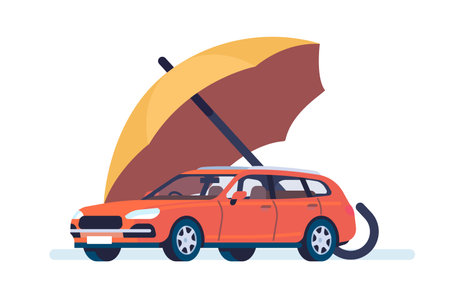Introduction to Teen Auto Insurance in the U.S.
If you’re a teenager (or a parent of one) getting ready to hit the road, auto insurance might seem confusing and even a little overwhelming. In the United States, car insurance is not just a legal requirement—it’s also an important safety net for new drivers who are still learning the ropes. Teen drivers face unique challenges when it comes to car insurance, mostly because of their limited driving experience and higher risk of accidents. That’s why insurance rates for teens can be much higher compared to older, more experienced drivers. On top of that, each state has its own set of rules and laws that govern what type of coverage is needed, how much it costs, and when teens can start driving independently. Understanding these local laws is super important because it helps keep young drivers safe and ensures they’re following the rules. In this article, we’ll take a closer look at why teen auto insurance is different, what makes it challenging, and why knowing your state’s specific requirements can make all the difference as you start your driving journey.
2. Minimum Insurance Requirements for Teens by State
Understanding the minimum insurance requirements for teen drivers can be pretty overwhelming, especially because every state in the U.S. has its own specific rules and coverage limits. When you’re a new driver (or a parent of one), knowing these basics is essential to stay legal and protected. In most states, teen drivers must carry at least liability insurance before they can hit the road. Liability insurance covers injuries or damages you might cause to other people or property in an accident—but it won’t cover your own car’s repairs.
Liability Coverage: What Does It Mean?
Liability insurance typically includes two main parts: Bodily Injury Liability (BI) and Property Damage Liability (PD). Here’s what those terms mean:
- Bodily Injury Liability (BI): Pays for medical expenses if you injure someone in an accident.
- Property Damage Liability (PD): Covers repair or replacement costs if you damage someone else’s property.
State-by-State Minimums: A Quick Look
The required amounts for these coverages vary widely by state. To give you an idea, here’s a quick comparison of some states’ minimum liability limits for teen drivers:
| State | Bodily Injury per Person | Bodily Injury per Accident | Property Damage |
|---|---|---|---|
| California | $15,000 | $30,000 | $5,000 |
| Texas | $30,000 | $60,000 | $25,000 |
| Florida | $10,000 | $20,000 | $10,000 |
| New York | $25,000 | $50,000 | $10,000 |
| Illinois | $25,000 | $50,000 | $20,000 |
Add-Ons and Extra Requirements
Some states also require extra types of coverage beyond basic liability—like Personal Injury Protection (PIP) or Uninsured/Underinsured Motorist Coverage. These are designed to protect you and your family even more but do raise the overall cost of insurance for teens.
Why Do States Differ?
The differences in state requirements come from local laws and how much risk each state thinks should be covered. For example, densely populated states or those with higher accident rates may require higher minimum coverage. As a new driver or parent figuring all this out for the first time, it’s super important to check your state’s Department of Motor Vehicles (DMV) website for the most up-to-date info.

3. Graduated Driver Licensing (GDL) Laws Impact on Insurance
When it comes to teen drivers, most states in the U.S. use a Graduated Driver Licensing (GDL) system—a three-step process designed to give young drivers more experience before granting them full driving privileges. But did you know that these GDL laws can also have a big impact on auto insurance rates and requirements for teens? As someone new to all this, I was surprised by just how much these laws can affect what you’ll pay and how your teen gets insured.
GDL programs usually start with a learner’s permit stage, move to an intermediate or provisional license, and finally lead to a full license. Each stage comes with its own rules, like supervised driving hours or restrictions on nighttime driving and passengers. Insurers watch these stages closely because more restrictions often mean lower risk—and that translates into better rates for families. For example, states with stricter nighttime driving limits or passenger bans tend to see fewer accidents among teens, so insurers may offer slightly lower premiums in those areas.
But here’s where it gets interesting: not every state has the same GDL requirements. Some states require more practice hours or extend the time teens must spend at each stage, while others are less strict. This patchwork of rules means that insurance rates and coverage options for new drivers can vary a lot depending on where you live. In states with tougher GDL laws, insurance companies might feel more confident about insuring teen drivers, which could help lower costs—at least a little bit.
It’s also important to know that some insurers will ask for proof of completed driver education or specific GDL milestones before offering discounts or even basic coverage. So if your teen is working their way through the GDL program, keeping records and certificates handy is a smart move.
Bottom line: understanding your state’s GDL system is key if you want to manage costs and make sure your teen meets insurance requirements. Even as a beginner in this area, I’ve learned that talking to your insurer about local laws and available discounts can make a big difference for your family’s budget and peace of mind.
4. Common State-Specific Rules and Restrictions
When it comes to auto insurance laws for teen drivers, each state in the U.S. sets its own unique rules and restrictions. Some states have much stricter requirements than others, which can make things confusing if you’re a new driver or a parent trying to figure out what’s needed. Here are some of the key state-specific insurance regulations and provisions you should know about:
Minimum Liability Coverage Requirements
Every state has its own minimum liability coverage that all drivers, including teens, must carry. However, the exact amounts can vary significantly. Here’s a quick comparison of how different some states can be:
| State | Bodily Injury per Person | Bodily Injury per Accident | Property Damage |
|---|---|---|---|
| California | $15,000 | $30,000 | $5,000 |
| Texas | $30,000 | $60,000 | $25,000 |
| Florida | $10,000 | $20,000 | $10,000 |
No-Fault vs. At-Fault States
Some states like Florida and Michigan operate under “no-fault” insurance systems, where your own insurance covers your injuries regardless of who caused the accident. In contrast, “at-fault” states like California and Texas require the driver who caused the accident (or their insurer) to pay for damages. This affects how claims are handled and what coverage is necessary for teen drivers.
Unique Provisions for Teen Drivers
- Graduated Driver Licensing (GDL) Insurance Mandates: Many states have specific insurance rules tied to their GDL programs. For example, in New York, teens must show proof of insurance before even getting a learner’s permit.
- Higher Premiums for Young Drivers: States like New Jersey allow insurers to charge higher premiums specifically for drivers under 21 due to higher risk profiles.
- Add-On Requirements: In North Carolina and Louisiana, teens are often required to be listed as “named insureds” on family policies instead of just being occasional drivers.
Strict Penalties for Lapses in Coverage
Certain states are particularly strict if there is any lapse in insurance coverage. For instance, in Massachusetts and Oklahoma, even a short gap could result in license suspension or hefty reinstatement fees—something new drivers need to be very careful about!
Overall, these rules highlight just how important it is for both teens and their families to understand local insurance laws before hitting the road. Every state’s system is a bit different, so always check your own state’s DMV or insurance department website for details.
5. How Parents and Guardians Are Involved
When it comes to teen drivers and auto insurance in the United States, parents and guardians play a huge role. As a new driver, you might feel excited about hitting the road on your own, but from an insurance perspective, it’s almost always a family affair. Understanding how parental responsibilities work, what co-signing means, and how family insurance plans are set up can make the whole process less intimidating.
Parental Responsibilities for Teen Drivers
In most states, teens under 18 cannot legally sign contracts on their own—including car insurance policies. That means your parent or legal guardian has to step in as the responsible adult. They’re not just signing paperwork; they’re accepting financial responsibility if you cause an accident or rack up traffic violations. Some states even require parents to certify that their teen has completed required practice driving hours or passed specific safety courses before getting a license.
Co-Signing Insurance Policies
Co-signing is a common requirement for teen auto insurance. Basically, your parent or guardian signs the policy with you, agreeing to cover any costs if you can’t pay. This ensures the insurance company gets paid no matter what, but it also means your parents’ credit and finances are on the line if there’s a problem. Because of this extra risk, many families add teens to an existing policy instead of starting a brand new one—this can also help save money.
How Family Insurance Plans Work for Teens
Most U.S. families choose to add their teen driver to their current auto insurance plan rather than buying a separate policy. This is usually cheaper because multi-car and multi-driver discounts often apply. The premium will go up (teens are considered high-risk), but it’s still less expensive than having two separate policies. When you’re on your family’s plan, any accidents or tickets you get could affect everyone’s rates—not just yours—so there’s extra incentive to drive safely.
The Bottom Line for Parents and Teens
Navigating auto insurance as a teen is definitely a team effort between you and your parent or guardian. From signing documents to sharing financial risks, understanding each person’s role is key to making smart decisions about coverage and keeping everyone protected on the road.
6. Tips for Teens and Families to Save on Auto Insurance
Auto insurance for teen drivers can be surprisingly expensive, but there are plenty of ways families across the U.S. can save money without sacrificing essential coverage. Here are some practical tips and discount opportunities that work in many states:
Shop Around and Compare Quotes
Not all insurance companies treat teen drivers the same. Rates can vary widely from one insurer to another, even within the same state. Take time to get multiple quotes and don’t hesitate to ask about state-specific programs or discounts for young drivers.
Take Advantage of Good Student Discounts
Many insurers offer significant discounts if a teen maintains a high GPA—usually a “B” average or better. This is a popular incentive across most states, so make sure to submit report cards each semester as proof.
Consider Driver Education Courses
Completing an approved driver’s education course not only helps teens develop safer habits behind the wheel but often qualifies them for additional discounts. Check your state’s requirements and available courses, as these savings can add up quickly.
Add Teens to an Existing Family Policy
Rather than getting a separate policy, adding a teen to a parent’s existing auto insurance plan is usually much more cost-effective. Bundling policies together can also unlock multi-car or multi-policy discounts.
Select the Right Car
The type of car your teen drives plays a big role in determining insurance rates. Older vehicles with strong safety ratings and lower horsepower tend to be cheaper to insure. Avoid flashy sports cars and look for models that qualify for safety-related discounts in your state.
Increase Deductibles (With Caution)
Raising your deductible—the amount you pay before insurance kicks in—can lower monthly premiums. However, make sure your family could comfortably cover the higher out-of-pocket costs if there’s an accident.
Explore State-Specific Programs
Some states offer unique programs or incentives aimed at making insurance more affordable for young drivers, such as graduated licensing laws or safe driving rewards. Ask your agent about any local opportunities that might help you save.
Practice Safe Driving Habits
A clean driving record is one of the best ways to keep insurance costs down over time. Encourage your teen to avoid tickets and accidents—not just for their safety, but also for long-term savings on auto insurance premiums.
Together, these strategies can make insuring a teen driver more affordable, no matter which state you call home.
7. Conclusion: Navigating Auto Insurance as a Teen Driver
Understanding auto insurance laws for teen drivers across the United States can feel overwhelming, but being informed is the first step toward safety and responsibility. Each state has its own unique requirements, from minimum coverage limits to specific rules for young drivers, so it’s vital to research and stay up-to-date on your local laws. For teens and their families, taking a proactive approach means not only meeting legal requirements but also seeking out discounts, maintaining good driving records, and engaging in open conversations about safe driving habits. Adapting to these rules may seem daunting at first, but remember—staying educated and flexible helps everyone make smarter choices on the road. By working together and keeping an eye on changes in state regulations, teens and their families can confidently navigate the complexities of auto insurance and create safer driving experiences for all.


